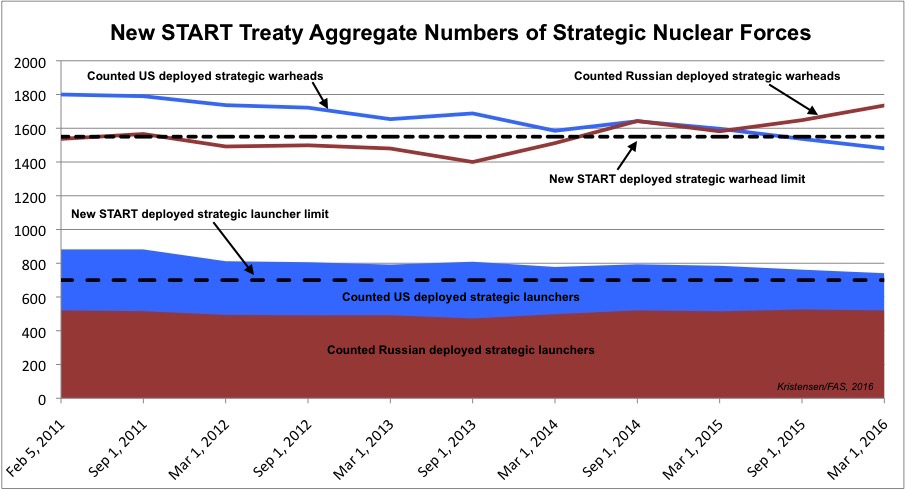New START Data Shows Russian Increases and US Decreases
By Hans M. Kristensen
[Updated April 3, 2016] Russia continues to increase the number of strategic warheads it deploys on its ballistic missiles counted under the New START Treaty, according to the latest aggregate data released by the US State Department.
The data shows that Russia now has almost 200 strategic warheads more deployed than when the New START treaty entered into force in 2011. Compared with the previous count in September 2015, Russia added 87 warheads, and will have to offload 185 warheads before the treaty enters into effect in 2018.
The United States, in contrast, has continued to decrease its deployed warheads and the data shows that the United States currently is counted with 1,481 deployed strategic warheads – 69 warheads below the treaty limit.
The Russian increase is probably mainly caused by the addition of the third Borei-class ballistic missile submarine to the fleet. Other fluctuations in forces affect the count as well. But Russia is nonetheless expected to reach the treaty limit by 2018.

The Russian increase of aggregate warhead numbers is not because of a “build-up” of its strategic forces, as the Washington Times recently reported, or because Russia is “doubling their warhead output,” as an unnamed US official told the paper. Instead, the temporary increase in counted warheads is caused by fluctuations is the force level caused by Russia’s modernization program that is retiring Soviet-era weapons and replacing some of them with new types.
Strategic Launchers
The aggregate data also shows that Russia is now counted as deploying exactly the same number of strategic launchers as when the New START Treaty entered into force in 2011: 521.
But Russia has far fewer deployed strategic launchers than the United States (a difference of 220 launchers) and has been well below the treaty limit since before the treaty was signed. The United States still has to dismantle 41 launchers to reach the treaty limit of 700 deployed strategic launchers.
The United States is counted as having 21 launchers fewer than in September 2015. That reduction involves emptying of some of the ICBM silos (they plan to empty 50) and denuclearizing a few excess B-52 bombers. The navy has also started reducing launchers on each Trident submarine from 24 missile tubes to 20 tubes. Overall, the United States has reduced its strategic launchers by 141 since 2011, until now mainly by eliminating so-called “phantom” launchers – that is, aircraft that were not actually used for nuclear missions anymore but had equipment onboard that made them accountable.
Again, the United States had many more launchers than Russia when the treaty was signed so it has to reduce more than Russia.
New START Counts Only Fraction of Arsenals
Overall, the New START numbers only count a fraction of the total nuclear warheads that Russia and the United States have in their arsenals. The treaty does not count weapons at bomber bases or central storage, additional ICBM and submarine warheads in storage, or non-strategic nuclear warheads.
Our latest count is that Russia has about 7,300 warheads, of which nearly 4,500 are for strategic and tactical forces. The United States has about 6,970 warheads, of which 4,670 are for strategic and tactical forces.
See here for our latest estimates: https://fas.org/issues/nuclear-weapons/status-world-nuclear-forces/
See analysis of previous New START data: https://fas.org/blogs/security/2015/10/newstart2015-2/
The research for this publication was made possible by a grant from the New Land Foundation, and Ploughshares Fund. The statements made and views expressed are solely the responsibility of the author.
Satellite imagery of RAF Lakenheath reveals new construction of a security perimeter around ten protective aircraft shelters in the designated nuclear area, the latest measure in a series of upgrades as the base prepares for the ability to store U.S. nuclear weapons.
It will take consistent leadership and action to navigate the complex dangers in the region and to avoid what many analysts considered to be an increasingly possible outcome, a nuclear conflict in East Asia.
How the United States responds to China’s nuclear buildup will shape the global nuclear balance for the rest of the century.
The bootcamp brought more than two dozen next-generation open-source practitioners from across the United States to Washington DC, where they participated in interactive modules, group discussions, and hands-on sleuthing.